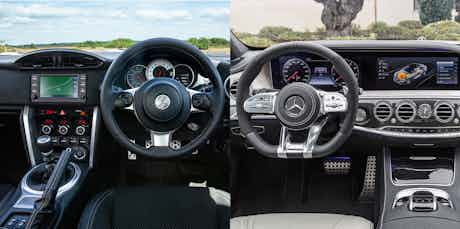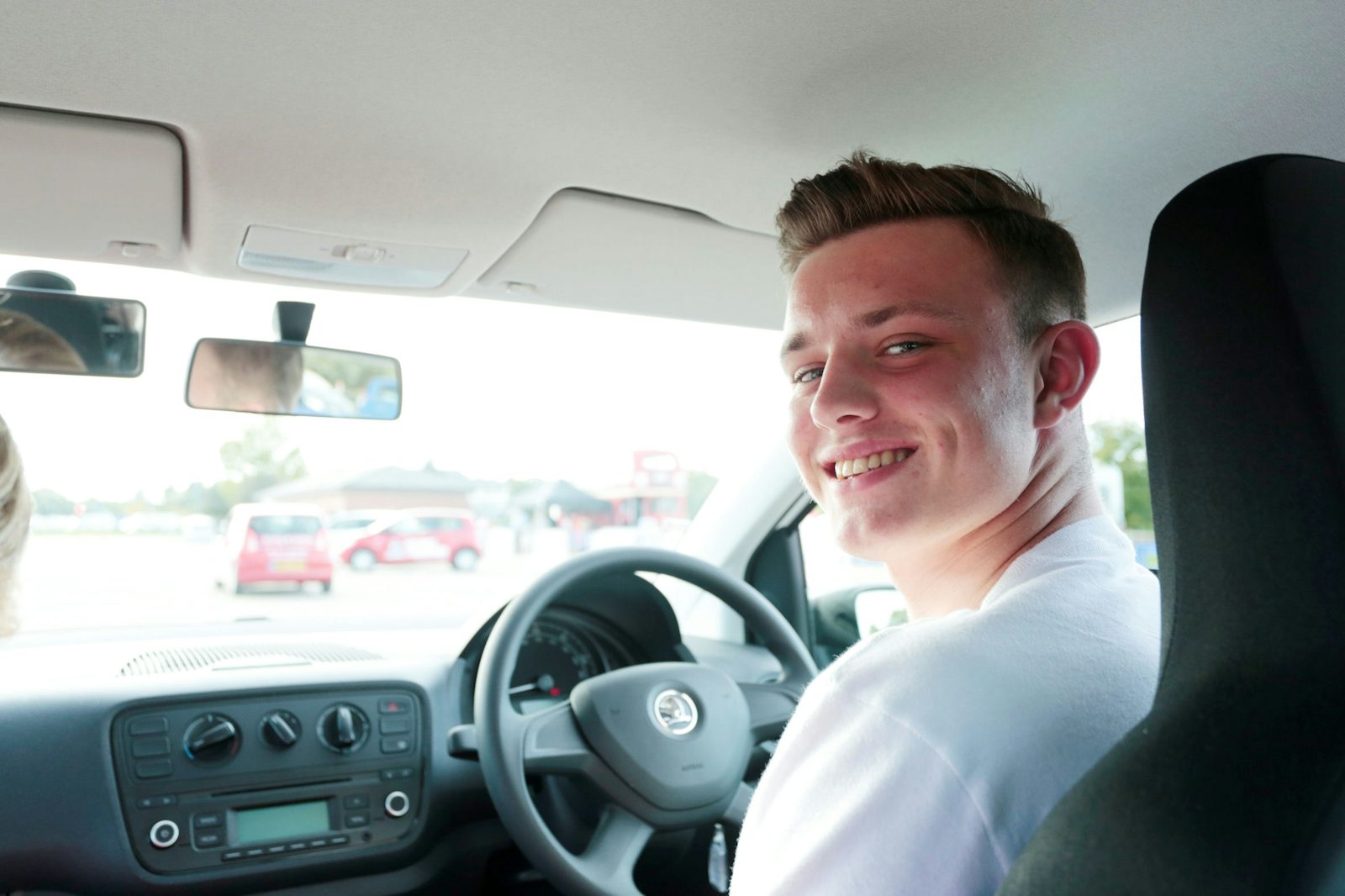Manual vs automatic cars: which is better?
January 10, 2025 by David Motton

One of the big choices to make when buying a car is choosing between a manual and an automatic. There are important differences between a manual and an automatic car, and pros and cons to both. This Carwow guide will help you decide whether a manual or automatic car is better for you.
What’s the difference between a manual and automatic cars?
The key difference is the type of gearbox fitted to the car. A manual gearbox has a gear lever and a clutch pedal (as well as an accelerator and a brake), and it’s up to the driver to decide when to change gear.
An automatic car has no clutch pedal. Either the clutch is automated (this is the case with Volkswagen’s DSG auto), the car has a torque converter, or it is fitted with a continuously variable transmission (CVT). Let’s not get bogged down in technicalities – whatever type of automatic gearbox the car uses, the important difference to a manual is that the car changes gear for the driver.
Should I buy a manual car?
The choice between a manual and automatic car is largely down to personal preference. There are pros and cons to both types of gearbox, and fans of one kind may dislike the other. Some drivers enjoy driving both manual and automatic cars, changing their preference depending on the kind of journey.
As a rule, manual cars take more skill to drive. Some drivers find them more fun, but they can be more tiring, especially in stop-start traffic.
Pros of manual cars
These are some of the most notable advantages of choosing a manual car:
- More precise control over the car.
- Greater involvement for keen drivers.
- Cars with a manual gearbox are usually cheaper to buy.
- Manuals are generally more fuel efficient.
Cons of manual cars
Here are some of the bad points to running a manual rather than an automatic:
- Manuals take more concentration to drive.
- Most hybrids and all electric cars aren’t available with a manual gearbox.
- Manual cars can stall, which isn’t a problem with an automatic car.
- Hill starts are more difficult with a manual gearbox.
- Can’t be driven by someone who has only passed their test in an automatic.

Should I buy an automatic car?
An automatic car is a great choice if you want to make driving as easy as possible. Around town, an automatic needs less physical effort than a manual car, as there’s no need to keep pushing down on the clutch pedal as you change gear.
Pros of automatic cars
Here are some of the benefits of choosing an automatic over a manual:
- Easier to drive.
- Less tiring in stop-start traffic.
- Gearboxes with a manual override aim to offer the best of both worlds.
- Choosing to drive an automatic means electric cars are available.
- No clutch to be worn while making a hill start.
Cons of automatic cars
Automatic cars won’t suit everyone. There are several downsides to running a car with an automatic gearbox rather than a manual:
- Usually more expensive to buy.
- Some drivers find automatics dull.
- As a rule, automatics are more expensive to maintain than manuals.
- Fuel bills can be higher if a car is fitted with an automatic gearbox.
- Automatic cars don’t have engine braking, which removes one way for a driver to control the car’s speed.
Are manual cars more fuel efficient than automatics?
It’s not a hard and fast rule, but manuals are often more economical than automatics with the same engine.
The difference used to be pronounced, as older automatic gearboxes were heavy, inefficient, and had fewer gears than most manual cars.
Modern autos have as many gears as manuals, if not more, which has helped to close the gap in fuel efficiency. They are also lighter and more advanced in design than older automatic gearboxes.
It’s worth noting that some of the most efficient modern cars are hybrids with automatic gearboxes, so you shouldn’t assume that a modern automatic car will be thirsty.
Driving style plays a big part in real-world fuel economy. Someone who revs the engine hard in a car with a manual gearbox may find that any on-paper advantage in fuel economy disappears if they don’t choose the most efficient gear.
Manual vs automatic: which is best?
Now you are putting us on the spot!
For new drivers, we’d favour a manual. If you cut your teeth in a manual, you will have a better understanding of how to control a car. Maybe you’ll switch to an automatic for your second or third car, but you won’t be able to do the same if you pass your test in an auto unless you take a second practical driving test in a manual.
Enthusiastic drivers may also prefer a manual. You’re more involved in driving a manual car than an automatic, and there’s satisfaction to be had from the skill needed to drive a manual car really well. That said, automatic cars with gearchange paddles behind the steering wheel can also be good fun to drive, narrowing the gap between manuals and automatics for keen drivers.
Perhaps you have a dull commute in stop-start traffic. If that’s the case, we’d recommend an automatic. Tedious drives are less of a chore if you can give your left leg a rest.
If you want a low-emissions hybrid or a zero-exhaust-emissions electric car, then you may not have any choice – an automatic is usually the only type of gearbox available.
It really does depend on the kind of car you are buying, the sort of journeys you make, and personal preference.
Manual vs automatic cars FAQs
Are there cars that are both automatic and manual?
Lots of cars are available with a choice of manual and automatic gearboxes. The closest you can get to combining both is an automatic car with a manual override function. This allows the driver to take charge of gear selection whenever they want to, while letting the auto ’box take the strain when they don’t.
Is it better to drive manual or automatic in the UK?
Given how busy the roads are, it’s tempting to decide that an automatic suits UK driving better than a manual. However, it really is a question that each individual has to answer for themselves.
Should my first car be manual or automatic?
Ideally, it’s better to learn to drive in a manual. That’s because if you pass your test in a manual you can also drive an automatic. On the other hand, if you really don’t get one with a manual car and only plan to drive an auto, there’s no need to put yourself to the trouble of learning to drive a manual.
Is it worth learning to drive automatically?
If you can’t or don’t want to drive a manual, then by all means learn to drive in an automatic car. There’s a bigger choice of automatics than ever before, and all electric cars on sale in the UK are automatic.
Can I drive a manual car with an automatic licence?
No, you can’t drive a manual car with an automatic licence. You will need to pass your practical test again in a manual to earn the right to drive a manual car on UK roads.
Cars Change? Carwow!
Looking for a new set of wheels? With Carwow you can sell your car quickly and for a fair price – as well as find great offers on your next one. Whether you’re looking to buy a car brand new, are after something used or you want to explore car leasing options, Carwow is your one stop shop for new car deals.















